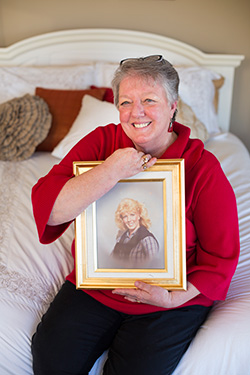A Great Loss Births a Calling to “Make Nurses”
 A still, small voice whispered: "You're going to do something special."
A still, small voice whispered: "You're going to do something special."
At just 7 years old, it was a vivid moment—anchored by the breathtaking beauty of a pastoral sunrise on a farm—that never stopped stirring Bobbie Lovell's soul.
"I know that I am supposed to do something special," Bobbie plainly told her husband, Charlie, the morning of her 50th birthday.
"You were supposed to rescue me," he quipped.
"That's sweet, but that's not it."
Just like Charlie has been to her, Bobbie's been a human life vest to her husband of 50 years. She championed for his health while Charlie wrestled with Crohn's disease; she was Charlie's right-hand in his subcontracting business of installing acoustic ceilings for 30 years.
When their only child, Connie, became debilitated by the relentless pain of an enraged, misfiring trigeminal nerve at the base of her brain, hospital waiting rooms and treatment centers became Bobbie's home away from home.
Bobbie's had her fair share of medical appointments, too, as a two-time breast cancer survivor, so one more emergency room visit was a good day because "Connie was still here," she says, "fighting a battle I wanted to go to war for."
Described by the medical world as the most excruciating pain known to humanity, trigeminal neuralgia "took us from Vanderbilt to Duke to the Cleveland Clinic in Ohio," says Bobbie, "and from hypnosis to acupuncture."
In the ditches of sickness and darkness, Bobbie, an exquisite grande dame still life painter, adamantly looked for ways to crawl out and find morsels of splendor through her paintbrush. Even if it meant tightly shutting her eyes to reimagine a spring day trekking with her easel to Cades Cove to gaze upon the intricate, yet delicate, petals of orchids and trillium covering a mountainside like carpet.
"There was nothing... absolutely nothing made the pain and all the complications that came with it stop," Bobbie says of the intensity of Connie's anguish.
Death brought agony to a halt in 2003. At 37, Connie died.
A relentless patient for a decade, Connie never stopped being a nurse.
The UT Knoxville College of Nursing 1993 graduate was figuring out what side effects ailed her body from her hospital bed.
"Cardiac tamponade" Connie wrote on a dry erase board, unable to speak, after the near-death episode caused her heart to function abnormally because of blood filling up between her heart muscle and the heart's outer cover sac.
"Lucky" was all she had to write when the nurse confirmed her suspicions of what happened in surgery.
"I thought she was going to write ‘I love you, mom,'" Bobbie said, laughing.
"Even in that dire moment, she was still very much a nurse."
At 5 feet 2 inches tall, 97 pounds, with strawberry blonde hair, Connie dreamed about becoming the next Barbara Walters. But by her junior year of studying communications, she knew asking someone how they felt in the midst of tragedy was not her calling; nursing was. It meant she could be part of phenomenal healing in the worst of times.
Like a giddy kindergartener on a sugar rush, Connie, by then a nursing student, barged into the house, "Mom, mom, let me see your hand.
"Did you know that this bone is made specifically to fit into this bone, and this bone fits into this one, and there is not another bone in all the universe like it," Connie rattled off while examining her mother's hand. "Oh mom, what an architect we have!"
Excited about every class and clinical rotation, Connie especially admired former Knoxville nursing professor Kathleen Conlon.
"She was always coming home and telling me something about Mrs. Conlon," says Bobbie.
"I didn't know Mrs. Conlon, but something told me to call Mrs. Conlon."
That phone call, nine years after grieving the loss of her daughter, was anything but serendipitous for Bobbie.
"That phone call," she says, "opened the door for me to think about establishing a scholarship in memory of Connie.
"I was exactly where I needed to be."
As the years came and went, the daily constant for Bobbie was being in front of a canvas in her art studio, tucked away down the hill from a retirement haven on Douglas Lake.
"The opportunity to capture on canvas the beauty of color and light makes my heart sing," says Bobbie, who picked up her first paintbrush in her 20s. Under the watchful tutelage of Arline Hoff, who was trained at the National Academy in New York, Bobbie began creating oil paintings that warranted her signature, and she still remembers what Hoff pressed upon her as she teaches others her passion.
With a palette containing only the three primary colors, Bobbie is moved, time and time again, "by the emotional attachment of an object or scene.
"And so was Connie. She had an artful eye.
"She loved my paintings," Bobbie says. "And she never wanted me to sell or give away my paintings because she wanted every single one."
From a portrait of Connie's Raggedy Ann doll—"In Stitches"—to "Vision of Hope," Bobbie rarely sold her paintings.
That's changed for the sake of nurses like Connie.
Along with generously donating one or two paintings to the silent auction of the College of Nursing's annual NightinGala, she also gives the proceeds of every painting sold back to the legacy of Connie through the creation of an endowed scholarship in Knoxville's College of Nursing.
"I am making nurses," Bobbie says. "That is my something special."
